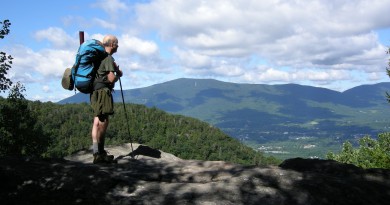Green Mountain Club turns 90
By
Michael Roche
Posted September 1st, 2000
For more information about the Green Mountain Club call 802-244-7037 or visit their Web site, greenmountainclub.org
T hink for a minute—what would Vermont be like without the
Green Mountain Club?
The Club’s 15 full-time staff and 30 part-timers maintain the Long Trail, a hiking path that runs from Massachusetts to Quebec along the spine of the Green Mountains. You could stand in the valleys and look at the mountains, but getting to the top of them would be incredibly difficult. Without the Green Mountain Club (GMC), reaching Vermont’s peaks on foot would require hiking along creeks and rivers because the forest’s dense foliage is often impenetrable. The mountains of Vermont, the very thing that defines this state, would be practically inaccessible.
Ben Rose, the executive director of the GMC, thinks the mountains in Vermont would be much like they were before 1910 when the club was founded.
“The mountains would be a dark and brooding place, an impediment to transportation,” says Rose. “Instead, envisioning the trail, the founder, James Taylor, opened up the mountains as a place of celebration.”
It appears that Rose is working his dream job. His previous occupations were virtual steppingstones to his present position. In 1984 he co-founded the Catamount Trail Association, an organization dedicated to creating a cross-country ski trail the length of Vermont, and was its first executive director from 1986-1988. He left that position to become executive director of the Central Vermont Solid Waste Management District until 1994. In the mid-1990’s, he twice represented Williston in the Vermont State House. By 1998, Rose was at the helm of the Green Mountain Club. He has settled into his new position and seems to enjoy expressing his philosophy about the mountains.
“People relate to the ridgelines and are connected to the mountains; hopefully they will look at the Long Trail as part of that,” adds Rose. “The Trail creates a human dimension to that spine of mountains that you see. Because of the Green Mountain Club, a person can look at the mountains and think, ‘I can go up there.’”
Still, the GMC is a non-profit, and like all non-profits it is competing for people’s hard-earned money to continue its existence. How then, can an organization like the GMC convince people that it deserves their dollars over charities whose missions are to reduce human suffering?
Rose responds: “Certainly, every year we need to allocate a certain piece of our earnings to reduce suffering, but if all we did was spend our time trying to fix what is bad instead of affirming what is good and celebrating it, what would be the point? The GMC is local. It’s community based. A dollar has a disproportionate impact [compared to international charities] when we are trying to protect a 445-mile trail system. Much of what charities do is to treat problems and it’s hard to get to root causes. Because the Green Mountain Club is active and positive we are doing something—we are going more to the root [for improving people’s lives] and not so much treating the symptoms.”
More than 200,000 people hike part of the Long Trail every year, yet there are only 8,000 GMC members. These members contribute over half of the organizations $1.2 million dollar budget. The rest of the annual funds are raised from corporations, state grants, and about $50,000 in interest from the Club’s endowment fund. Despite the disproportionate amount of trail use versus the actual number of GMC members, Rose still recognizes the positive.
“It would be nice on a systemic level if more people joined, but if someone spent a few days hiking on the Long Trail, renewed their spirit, and then gave $10,000 dollars to Doctors Without Borders, that would be great, too. So, we don’t begrudge anybody a hike.”
The State of Vermont has partnered with the GMC in the Long Trail Protection Campaign. Buying and permanently protecting the trail over the last decade has cost more than $6.5 million dollars, with the state contributing $3.4 million. The Club has raised the rest. Rose estimates it will take another million to purchase the remaining land, a necessity that became obvious over a decade ago as land-use patterns changed.
“For 70 years, access to the trail worked great on handshakes,” says Rose. “Vermont had a tradition of free passage to go tromping around the woods and to go hunting and fishing. It wasn’t until the mid-1980’s that land ownership and attitudes changed. That made us to realize that if we want to have a trail in 100 years, we better buy the thing.”
With that in mind, Rose expresses his dreams for the Green Mountain Club in the next five and ten years:
“In five years I see us wrapping up the Lamoille and Winooski River relocations; essentially rerouting the trail to the right place.”
Rose also wants to encourage use of other trail systems throughout the state. This would help reduce hiking pressures on the Long Trail while still promoting the sport.
Ten years from now is the centennial celebration for the Long Trail. One year earlier, in 2009, Vermont will host the Appalachian Trail Conference. Each group that oversees the Appalachian Trail, which runs from Georgia through Vermont and into Maine, will attend. The conference’s date is close enough to the actual centennial that Rose plans on a big “blowout.”
By 2009, the Long Trail will hopefully be in the right place and protected; no one can shut it down. The $1 million-dollar endowement will be signifcantly larger. In short, all the work of the first 100 years will be complete and the GMC can enter its second century with a sense of sustainability.
Right now, any of 20 landowners could shut down part of the Long Trail, thus ruining its continuity. The Club has excellent relations with all of them, but each time the Vermont Legislature passes a new tax or logging restriction bill on large landowners, there becomes a sense by these people of, “Why am I letting all these strangers on my land?” The Long Trail has become hostage to legislative measures that it cannot control. By owning the land, the GMC will control its own destiny, a destiny Ben Rose plans on being a part of for some time to come.
This September, the GMC will be 90 years old, and as its Executive Director, Rose knows he is in an important position. Yet he holds the very club that he oversees in awe. “I see myself as being handed a Ming vase, and I must not drop it,” he says. “It should keep going, as long as I don’t screw it up.”
Michael Roche is an arborist in Morrisville. He has been hiking the Green Mountains for over 20 years. He and his wife, Suzannah, have an eight-month-old boy, and even though Kyle just started crawling, Michael figures he will be cross-country skiing this winter.


